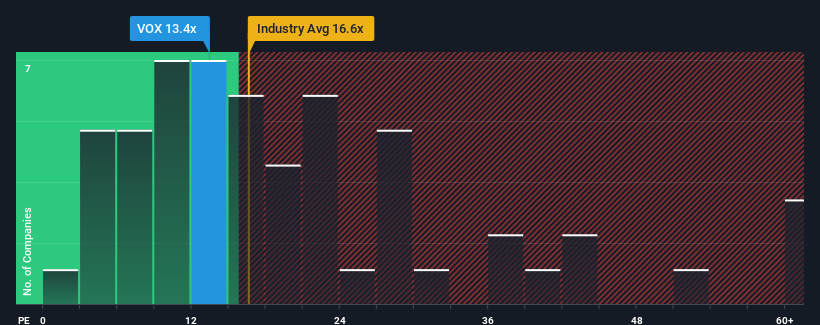- Poland
- /
- Healthcare Services
- /
- WSE:VOX
Further Upside For Voxel S.A. (WSE:VOX) Shares Could Introduce Price Risks After 39% Bounce
The Voxel S.A. (WSE:VOX) share price has done very well over the last month, posting an excellent gain of 39%. The last 30 days bring the annual gain to a very sharp 96%.
In spite of the firm bounce in price, it's still not a stretch to say that Voxel's price-to-earnings (or "P/E") ratio of 13.4x right now seems quite "middle-of-the-road" compared to the market in Poland, where the median P/E ratio is around 13x. However, investors might be overlooking a clear opportunity or potential setback if there is no rational basis for the P/E.
Voxel has been doing a good job lately as it's been growing earnings at a solid pace. One possibility is that the P/E is moderate because investors think this respectable earnings growth might not be enough to outperform the broader market in the near future. If that doesn't eventuate, then existing shareholders probably aren't too pessimistic about the future direction of the share price.
See our latest analysis for Voxel

Does Growth Match The P/E?
In order to justify its P/E ratio, Voxel would need to produce growth that's similar to the market.
If we review the last year of earnings growth, the company posted a worthy increase of 15%. Pleasingly, EPS has also lifted 212% in aggregate from three years ago, partly thanks to the last 12 months of growth. Accordingly, shareholders would have probably welcomed those medium-term rates of earnings growth.
This is in contrast to the rest of the market, which is expected to grow by 7.8% over the next year, materially lower than the company's recent medium-term annualised growth rates.
In light of this, it's curious that Voxel's P/E sits in line with the majority of other companies. Apparently some shareholders believe the recent performance is at its limits and have been accepting lower selling prices.
The Key Takeaway
Its shares have lifted substantially and now Voxel's P/E is also back up to the market median. It's argued the price-to-earnings ratio is an inferior measure of value within certain industries, but it can be a powerful business sentiment indicator.
We've established that Voxel currently trades on a lower than expected P/E since its recent three-year growth is higher than the wider market forecast. When we see strong earnings with faster-than-market growth, we assume potential risks are what might be placing pressure on the P/E ratio. It appears some are indeed anticipating earnings instability, because the persistence of these recent medium-term conditions would normally provide a boost to the share price.
We don't want to rain on the parade too much, but we did also find 1 warning sign for Voxel that you need to be mindful of.
If you're unsure about the strength of Voxel's business, why not explore our interactive list of stocks with solid business fundamentals for some other companies you may have missed.
New: Manage All Your Stock Portfolios in One Place
We've created the ultimate portfolio companion for stock investors, and it's free.
• Connect an unlimited number of Portfolios and see your total in one currency
• Be alerted to new Warning Signs or Risks via email or mobile
• Track the Fair Value of your stocks
Have feedback on this article? Concerned about the content? Get in touch with us directly. Alternatively, email editorial-team (at) simplywallst.com.
This article by Simply Wall St is general in nature. We provide commentary based on historical data and analyst forecasts only using an unbiased methodology and our articles are not intended to be financial advice. It does not constitute a recommendation to buy or sell any stock, and does not take account of your objectives, or your financial situation. We aim to bring you long-term focused analysis driven by fundamental data. Note that our analysis may not factor in the latest price-sensitive company announcements or qualitative material. Simply Wall St has no position in any stocks mentioned.
About WSE:VOX
Flawless balance sheet and good value.
Market Insights
Community Narratives



